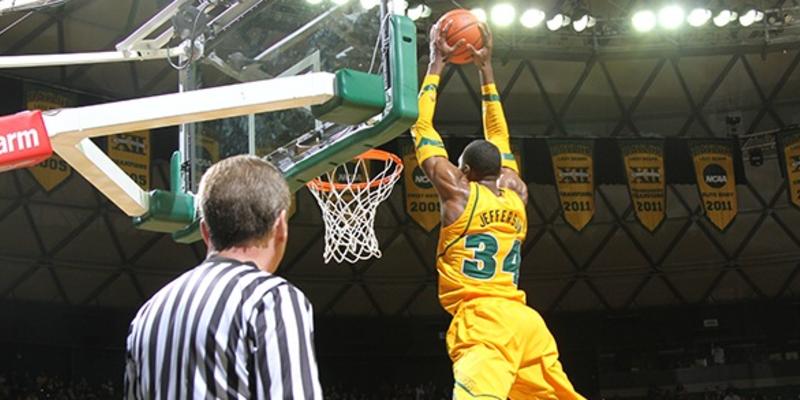
Nobody's going to forget to fill out their brackets this year. No sir, not with Cullen around, running up and down Grit's sidelines waving his arms, pumping up the crowd until we're on our feet stomping out a cadence until tip-off. March Madness is almost here, and you might as well stay tuned.... the man's got more to say as the games commence. We took a shine to "College Hoops: All Teams Equal in This Year's Tourney?" because a) he highlighted the possibilities, the unknowns, the sheer madness sure to come in this tourney, and that's damn exciting and b) he makes a long list of good points. Now, if he could only sit in for Dick Vitale come game time. (Sorry, Dickie V fans...)
After a season muddled by the merry-go-round of national rankings, the NCAA tournament looms unpredictable, like a wildcat who feeds solely off upsets and buzzer beaters. Why though has it been so wildly entertaining?
“Parity” is a term that is widely used to describe the balance of power that has brought pandemonium to college basketball this year. As conference tournaments roll on, the NCAA tournament selection status remains vague and uncertain. Even my preseason favorites—Kentucky and Baylor—needed big late-season wins (against Florida and Kansas, respectively) to elevate their status to “likely” NCAA tournament selections.
And ESPN is still paying college basketball analysts to predict unanswerable questions… Such as: Which four teams will receive #1 seeds? Which bubble teams are in and which are out? Which teams are destined to have successful tournament runs?
And although the unusual parity in college basketball is widely proclaimed, the big question remains:What the hell does it all mean?
Well, for college basketball aficionados who hang onto every last regular season dribble, the parity continues to be shocking, puzzling, and disconcerting all wrapped up into game after game of utter mystification.
On the other hand…
If you prefer the Dickie V rants and basketball-shaped cupcakes over the team chemistry and psychology, or the long traditions of storied programs, then this March is for you. Those of you who will pick the Minnesota Golden Gophers to upset the Kansas Jayhawks because of that disturbing wildlife documentary about birds of prey, this March is for you. If you fill out your bracket with alma mater bias, by flipping coins, or based on which school’s student section performed the best Harlem Shake, then this March is for you. Basically, the less analysis you put into your bracket, the better, because thus far, very little in college basketball this season has made sense or followed a linear logical path.
The parity may have some recruiting implications for college basketball as well. Up until now, the country’s top high school recruits have generally opted to travel across the country to play at the likes of UNC, Duke, UCLA, Kansas, or Kentucky. Now, with this newfound balance among basketball programs, highly-rated recruits may find that nearby “mid major” schools like Butler, Gonzaga, and VCU can provide equal or even better opportunities.
Not to mention the grandiose cheering section that a star point guard from inner city Richmond playing at VCU, or a dominant big man from Spokane controlling the paint at Gonzaga could have. Already, thanks in part to the viewing intimacy (no pads, helmets, hats, or long sleeves like in other sports) of basketball, we often recognize individuals more than the teams. (This is especially true in the NBA.)
If this parity caused “blue-chip” recruits to stay local, coaches like Kentucky’s John Calapari who thrive off of one-and-done type recruiting classes may have to seriously refine their recruiting strategies.
In my last blog, I took a jab at the sports betting world, saying, “parity is perilous (especially for Las Vegas).” Well it’s true; sports gambling is run on calculated probabilities, but when those odds are negated because of unexpected equality among competitors, it makes it virtually impossible for Vegas analysts to successfully predict the outcomes of games. How do you create lines, interpret betting trends, or generate over/under in a sport when all the teams are evenly matched?
Parity will also benefit dominant players at smaller schools by giving them bigger stages to play on. Think about Stephen Curry in 2008—before Davidson’s deep tournament run, most of the college basketball world hadn’t even heard of the silky-shooting Wildcat. But due to parity, Curry was given a chance to perform in the March lights, and did so in dazzling fashion. A year later, Curry was drafted by the Golden State Warriors as the seventh overall pick. An even better example of college basketball parity shinning light on players that may have otherwise gone unnoticed is Lehigh’s CJ McCollum who dethroned the mighty Duke in last year’s tournament with 30 points. Since then, McCollum has shot to the top of NBA draft boards around the country.
Despite all the good that parity can do for college basketball, I can’t help but wonder if perhaps it could drive a wedge between star players and their teams. It may be too early to tell, but in a sport that already tends to value individuals rather than teams, permanent parity is certain to have a profound effect on how we interpret and value college basketball.
Photo credit: The Baylor Lariat